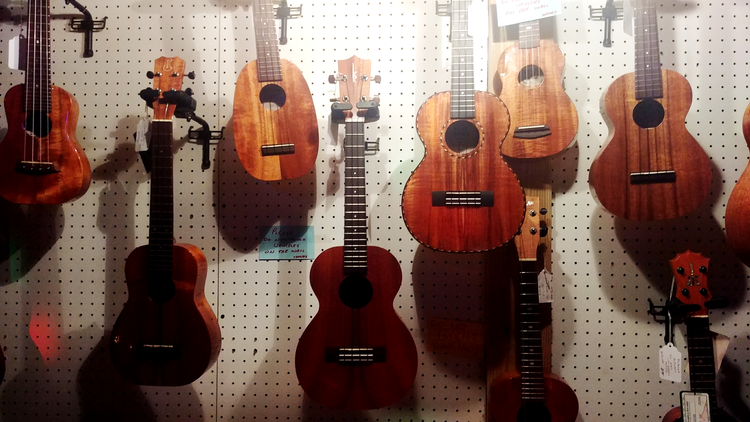
17 Apr We Love Uke!
The Jumping Flea, better known by its Hawaiian name of “Ukulele,” is above all an amateur’s paradise. Much of this is down to simple mechanics: with just four strings and a compact fretboard, the ukulele makes for easy playing. Like a pidgin language, the instrument strips away complexity of in favor of ease of expression: Literally, anyone can learn to play it.
Jumping Fleas for sale at the Uke Hut
This democratic eccentricity of the ukulele gives rise to a curious culture around the instrument, which is on ample display at Astoria’s own Uke Hut. As much a clubhouse as a business, the hut is as diminutive as its namesake, occupying all of a few dozen square feet at the corner of 36th Ave and 36th St in the heart of the Kaufman Arts District. With a tiny stage surrounded by candlelit cabaret tables, the hut is a warm, welcoming womb, gestating future generations of the city’s ukulele proud through lessons, instrument sales, and a copious events calendar.
“The Uke Hut is an outgrowth of the Ukulele Festival, which I did for 6 or 7 years in Manhattan,” notes owner Ken “Bari” Murray (more on that name later…). A beloved, if scattershot, affair, Ken’s Ukelele Festival brought travelling acts, open-mics, vendors, workshops, movies, food, and dance all under one roof for a week devoted to the art of the Jumping Flea. But, it was a lot of work: “It took us 6 months for one week,” recalls Murray. “It seemed somehow not logical. So I decided to open a permanent home.”

Ken “Bari” Murray with a guest
The current digs are the third iteration of the hut after several shot stints in Manhattan, and by all accounts, the Astoria location is Home. “My vendors from the festival are now my suppliers for the store,” Murray explains, “which basically just keeps us alive to do the other things we wanna do—primarily shows.”
Murray is aided in his pursuits by a small tribe of fellow uke enthusiasts who work in and around the shop. Foremost among them is Ms. Marie, his erstwhile booker and Thursday night host, who, like so many of Murray’s merry band, originally hails from Japan. “I was working for Colony Records, but I got laid off,” she recalls. “I got hired for sales at a kitchen store, but I was just suffering by myself. I wanted to switch the whole thing to music”
A chance conversation with Murray led to a job with the Hut, and the opportunity to inaugurate her own cabaret. “I started promoting the events, and now every Thursday, I make my own group,” Marie says. With special guests, both planned and impromptu, and a low-key vibe that favors boxed wine and potato chips, Ms. Marie’s Special Showcase on Thursdays is a moveable feast. The night I attended featured the Jon. B. Roche Trio, which, despite comprising only two people, featured local great Saul Rubin, better known as Sonny Rollin’s guitarist.

Saul Rubin plucks teh guts of a soprano Uke
As is a Uke Hut tradition, the show began at 8:08 (the area code for Hawaii), and a rapt audience of about 7 (including one young Japanese vocalist, Miki Yokoyama, whom Ms. Marie assured me is, “very famous in Japan.”) kept the candles burning late into the evening. And though she only played host on this night, Ms. Marie can often be found onstage singing. “I even sometimes dress up, and wear sparkles,” she notes with a laugh.
Mirroring Ms. Marie’s Special Showcase on Thursdays is Saturday night’s “Sakai & Friends,” hosted by fellow Uke-hut employee Masafumi Sakai, and featuring all manner of guitar- and uke-inflected jazz. Sundays are given over to the popular “Show and Tell” open-mic showcase, with various one-offs and lessons rounding out the display.
One thing that is not on display at the Uke Hut is ostentation of any sort. Humble almost to a fault – their website reads as gleefully “retro” – the various supporters and participants in the Uke Hut’s scene collectively eschew slickness in favor of a laid-back intimacy and ease of access — as befits their namesake instrument’s Hawaiian roots.
The byproduct of this aw, shucks demeanor is, significantly, joy. There is a palpable positivism to the Uke Hut that radiates off the small stage and fills the simple room. “The first time, I came here, I started looking around: People become positively happy!” recalls Ms. Marie. “It is because anyone can play. If someone says, ‘here, try: just ONE FINGER you can sing already.’” She explains. “Music is not that difficult when you meet and play together.”

8:08 at the Uke Hut
It all circles back to the amateur enthusiasm of Ken “Bari” Murray’s founding vision. A late-blooming Uke enthusiast himself – his middle name refers both to his baritone uke-of-choice, and his Japanese extended family – Murray’s venture is firmly rooted in community, not commerce. “It’s a full-time store, but my thing, in my heart, are the shows,“ he explains. “Whatever I have to do to keep live music live and going, that’s what I’ll do. That’s why we have a store.”



